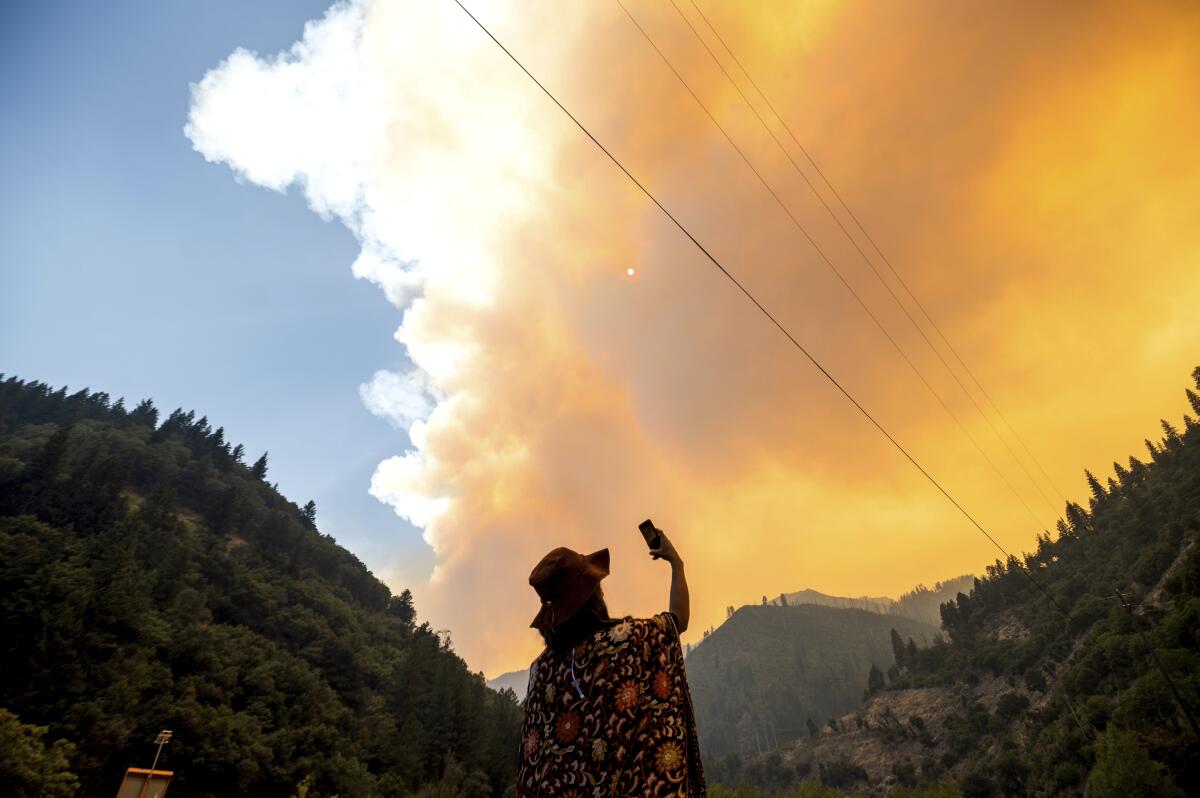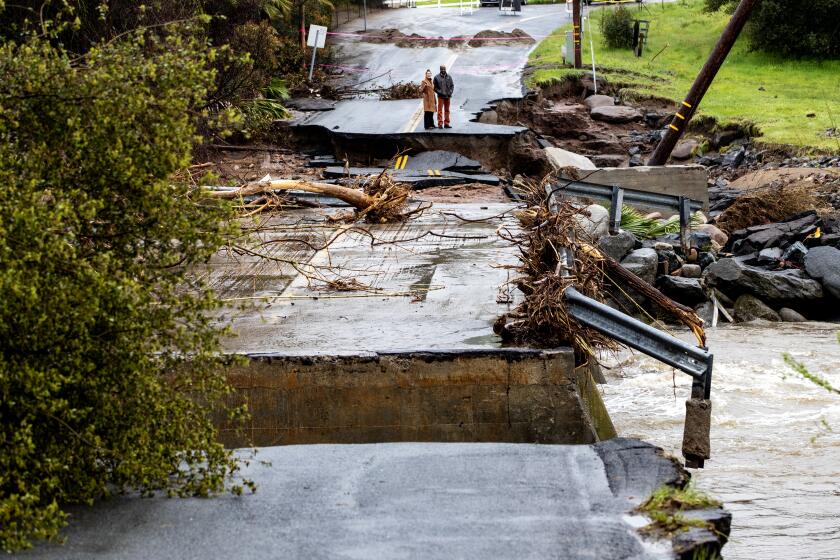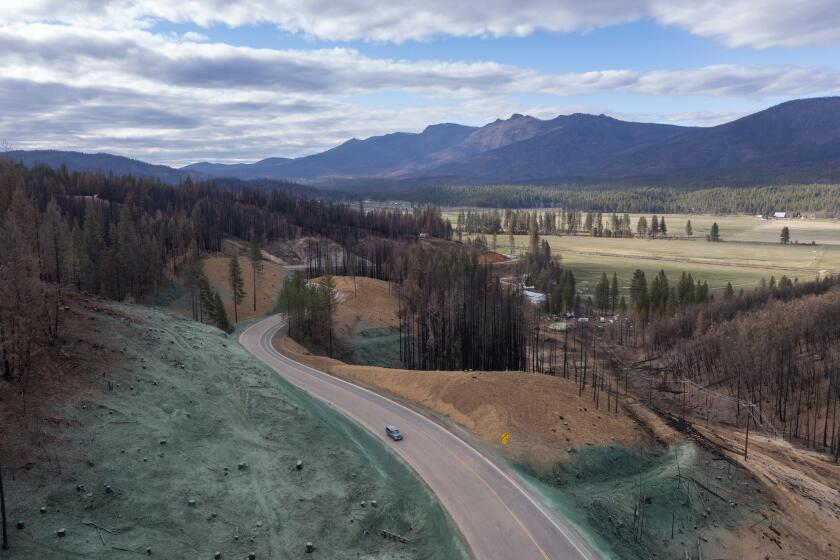Harris unveils $197 million for wildfire resilience as California’s fire season looms

- Share via
WASHINGTON — Storm-ravaged Californians are still digging out from historic levels of snowfall and girding for more heavy rain this week. But Biden administration officials are looking ahead to a wildfire season that could bring more devastation once the state dries out.
Vice President Kamala Harris detailed $197 million in new federal grants on Monday to help fortify high-risk communities against wildfires.
More than 100 communities scattered across 22 states and seven tribes will receive funding to supplement pay for wildland firefighters and provide housing for fire personnel as part of the Biden administration’s wildfire defense grant program.
“We used to talk about wildfire season. Now, wildfire season is all year round,” Harris said on a press call with Agriculture Secretary Tom Vilsack and Infrastructure Implementation Coordinator Mitch Landrieu. “We know the best time to fight a fire is before it starts.”
Twenty-nine of the grants will go to California communities and organizations.
Kern County will receive $2.2 million to train firefighters to conduct controlled burns and educate homeowners about reducing risk of wildfires, including cleaning rain gutters of dry sticks and leaves, which can be flammable agents, and covering vents to block flying embers.
Butte County’s fire department will receive $1.5 million to purchase excavator equipment for an 8,000-acre hazardous fuel reduction project and $4.9 million for defensible space inspections, which encourage homeowners to clear vegetation around their houses to reduce the possibility of wildfires setting them ablaze.
Tuolumne County will receive $10 million to inspect 1,290 homes, clear brush along approximately 23 miles of road and promote wildfire management education.
The grants will also boost U.S. Forest Service and Department of Interior funding for prescribed burning, brush-clearing and other wildfire-prevention tactics.
Last year’s Bipartisan Infrastructure bill and Biden’s signature climate and social spending package allocated $7 billion in funding for government agencies involved in wildfire management. The latest funding is an initial round and more money will be made available to other communities affected by wildfires, Vilsack said.
California’s wet season isn’t over yet. Central and Southern California residents are bracing for more rainfall after enduring 11 atmospheric river storms that dumped rain and snow across the state this winter. The storm systems, which pull moisture from the tropical Pacific, triggered mass flooding and breached levees.
More than a dozen locations along major rivers were overflowing as the storm moved south across California. About 336,000 people were without power.
Though the heavy rain and snow have brought some relief to the drought-stricken state, the precipitation could lead to extra growth of brush and grass that quickly turn to kindling in the summer and autumn months, according to Daniel Swain, a climate scientist at UCLA.
He pointed to the last wettest winter on record in parts of Northern California. A long, hot summer followed the winter of 2016-17, ultimately triggering the destructive Northern California firestorm in October 2017, including the Tubbs fire that devastated Santa Rosa. The severity of this year’s fire season will depend on how quickly the snowpack melts and whether temperatures heat up this spring and summer, Swain said.
“Just because we have a really wet winter does not mean that it’s obviously a mild fire season everywhere,” he added. “But it does change the dynamics.”
California wildfires have increased in both size and intensity over the last two decades, a pattern that has left little time for recovery between blazes. Harris recalled visiting communities ravaged by the Tubbs fire in 2017, the Camp fire in 2018 and the Creek fire in 2020.
“I have seen entire neighborhoods burned to the ground. I have been in neighborhoods where the only thing left standing [were] the chimneys, which looked almost like tombstones,” she said.
An increase in catastrophic wildfires has reduced California tree cover by 6.7% since 1985, and researchers fear the lost trees will never grow back.
Also on Monday, the United Nations released a bleak report that called on rich countries, including the U.S., to reach net zero emissions by 2040, a decade earlier than developing countries. The world is likely to exceed its climate target of limiting warming to 2.7 degrees Fahrenheit above pre-industrial times in the 2030s, a threshold that would yield catastrophic climate disasters, the report found.
“The assessment is dire,” Harris said of the UN report. “Our future is not yet written and the solutions are at hand. So let that be an alarm that lets us know that we must act with haste and we can actually, right now, have an impact on how this all plays out.”
More to Read
Get the L.A. Times Politics newsletter
Deeply reported insights into legislation, politics and policy from Sacramento, Washington and beyond. In your inbox three times per week.
You may occasionally receive promotional content from the Los Angeles Times.











